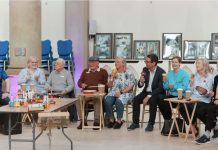Last month saw the Seashell Trust, a charity providing education and residential care for children and young adults with profound and multiple learning difficulties, officially open the new £23 million Moulding Foundation Building in front of over 130 patrons and supporters at its campus in Cheadle Hulme
The origins of the charity go back to the middle of Salford 200 years ago and About Manchester looks at its story
The story of Seashell starts in 1823 by Robert Philips and William Bateman who were two suucessful merchants in Manchester at the time,the former was the father of Manchester’s first ever MP, Bateman’s two children were deaf and dumb.
It was a remarkable beginning , when you think this is just eight years after the battle of Waterloo, what would the chances of a deaf child being educated in Manchester, in fact the chances of a child with any handicap getting any education at that time was unheard of in the region
A deaf school had already been set up in London, there was another one in Margate,so why not Manchester?
They met on the 18th June 1823, bringing together a group of like minded people with the purpose of raising funds to set up a school for the deaf
They rented accommodation in what was then known as the lying in school in Salford, the building had a view over the notorious prison at the time and The first school was opened in Stanley Street, Salford on 28th February 1825 with an initial intake of fourteen children.
Children were admitted between the ages of eight and thirteen, but often stayed until they were sixteen
Within just a year of its opening, the Manchester Mercury enthusiastically reported ‘several of the children can already articulate in a manner that could not have been anticipated, and are making rapid proficiency.’
The children were taught to read and write using an early form of sign language. This allowed them to play an active part in the wider world, giving them communication skills which had otherwise left them excluded.In those days,the most likely outcome of these people after they left education would have been some form of manual trade
However,it soon became clear that demand for the school would outweigh the accomodation.
A big fund raising drive was undertaken and they secured land from the De Trafford family, next to Manchester’s botanical gardens (It is now the site of the White City shopping mall in Old Trafford) and built a grandiose Victorian style deaf school.

The new school was opened on 21st June 1837
Such was the size of the building that they reached out to another institution,Henshaw’s Society for the Blind.The two combined, on one side a school for the blind, on the other,a school for the deaf.
This was the days before any form of state education and thus every child had to have a sponsor.The committee would go out into the region asking for sponsors to come forward.The Co-op was one such sponsor in those early days, along with benefactors wills and fundraising drives
Queen Victoria in her latter days would visit the school, recorded in her diary when a young girl presented a posy to her.Royal Patronage followed and the school became the Royal Residential School for the Deaf.
In the 20th Century,Trafford would change from being a pleasant green suburb to a centre of industry.The school was evacuated to Middlewich during World War 2 but it became clear to the trustees that more suitable land would be required, away from smog filled Manchester.
 With the help of a grant from the Department of Education and the sale of the land in Old Trafford, they moved to Cheadle Hulme, buying eighty acres of land and located a purpose built school which would open in the 1950’s.
With the help of a grant from the Department of Education and the sale of the land in Old Trafford, they moved to Cheadle Hulme, buying eighty acres of land and located a purpose built school which would open in the 1950’s.
The late 1970’s saw a move towards more inclusion in education and the trust was one of the first to realise that there was going to be a need to educate deaf children with more complexity.
Now deaf children would be education within the state system and the school began to focus on those pupils that required additional needs, opening up one the first sensorary impaired units in the country.
The story now moves to 2008 and there becomes a need to rebrand the charity.Deaf children now play a very role and the school is now educating children with brain damage,autism and physical disabilities.
The organisation changed its name to Seashell, using the logo of the charity that featured the cochlea of the ear, shaped like a seashell.
Buildings built in the 1950’s for deaf children really no longer served a purpose.In 2015 they opened a £10m development featuring seventeen residential houses named after Sir Norman Stoller who funded half the cost of the development.
It became the trigger for the redevopment of the whole campus, raising another £23m which last month saw the opening of the brand new school building in their bicentenary year, a state of the art building .
 The Moulding Foundation Building is the new home for Royal School Manchester, together with a wing that will house facilities to be shared with its specialist college, Royal College Manchester. These include an assembly hall for 200 people with retractable seating, a dining hall with both group and individual dining spaces, an assessment suite with a high-tech audiology suite and a swimming centre comprising a learner pool with a rise-and-fall floor and an interactive hydrotherapy pool.
The Moulding Foundation Building is the new home for Royal School Manchester, together with a wing that will house facilities to be shared with its specialist college, Royal College Manchester. These include an assembly hall for 200 people with retractable seating, a dining hall with both group and individual dining spaces, an assessment suite with a high-tech audiology suite and a swimming centre comprising a learner pool with a rise-and-fall floor and an interactive hydrotherapy pool.
Designed by Newcastle-based architects, Faulkner Brown, the building utilises a series of light-gatherers on the roof to provide indirect sunlight for the classrooms. Every part of the building has been acoustically designed in such a way to ensure little or no reverberation. Where it be individual classrooms or the large assembly and dining halls the needs of students with a hearing impairment or autistic spectrum disorders has been considered.
34 hoists in classrooms and shared spaces will ensure every student can access every space. 8 different sensory rooms, light stimulation rooms and low arousal rooms will be available to the teachers and learning support assistants to meet the needs of the students.
Let’s hope that Robert Philips and William Bateman are looking down on this new building and feeling very proud of what their idea has become 200 years later







